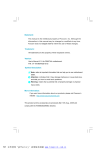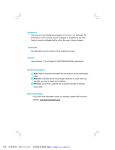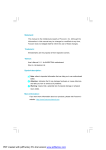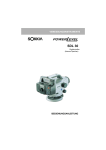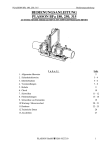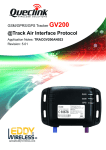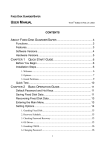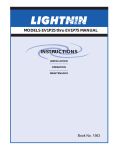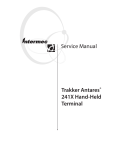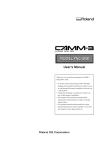Download berlin.de!
Transcript
From uwm.edu!spool.mu.edu!sol.ctr.columbia.edu!xlink.net!math.fuberlin.de!irz401!aw4 Fri Oct 15 12:33:08 CDT 1993 Article: 10094 of comp.sys.palmtops Path: uwm.edu!spool.mu.edu!sol.ctr.columbia.edu!xlink.net!math.fuberlin.de!irz401!aw4 From: [email protected] (Andreas Westfeld) Newsgroups: comp.sys.palmtops Subject: Quaderno FAQ Date: 15 Oct 1993 11:35:31 +0100 Organization: Dept. of Computer Science, TU Dresden, Germany Lines: 149 Distribution: world Message-ID: <[email protected]> Reply-To: [email protected] NNTP-Posting-Host: irz407.inf.tu-dresden.de Keywords: FAQ *** 1. What does xbios do though? (This is a TSR supporting int 15h, ax=44c0...44c9. See inter37?.zip) XBIOS is the low level interface to the Quaderno DSP and LCD indicator. XBIOS also contains the DSP vocoder code that is downloaded dynamically when the compression ratio changes. If you don't need the voice functions, you can safely not load XBIOS, the SPEECH TSR, and you can turn off Voice Manager using PASETUP, as you have already discovered :-}. The Quaderno System ROM contains a copy of the first release of XBIOS. Indeed it has some bugs, both in the vocoders and host interface. Since changing the ROM every time XBIOS changed was a real bother, we made XBIOS into a TSR. Please use the XBIOS TSR for Quaderno voice functions. *** 2. How to powerdown the HDD (without AC): write in the command line: debug park.com a pop ds mov word ptr [492],1 int 20 rcx 10 w q ______ Now you have the program park.com in the current dir. If you call park the same happens as after the hdd timer has expired. Mind the empty line after int 20! *** 3. Can I buy the connector elsewhere and make up my own cable? The connectors are manufactured by JAE and I heard from someone here in the states that they were available from a supplier. I believe the part number of the female (host) part of the adapter is: TX20A-36R-D2LT-A1LH. (cable) end. Knowing this I think you could get the male *** 4. Does anyone know the pinouts from the miniature parallel socket on the Quaderno? The pin-out includes all parallel and floppy disk lines. The pin-out is included in the service manual, which perhaps your dealer can get. *** 5. Why can I write and erase on the ROM-disk (D:)? The device you see as D: is actually combined ROM and 32 KB SRAM. Some of the RAM is used for configuration information (all your PA configuration preferences are stored there) and you can save some small files there if you want. You cannot erase the system files that reside there because these are actually in ROM. *** 6. Is it possible to make PA use the 320k EMS memory instead of over 200kB from the 640k main memory? taking Sorry, there is no way to make PA use the EMS memory. *** 7. Is there some trick to get it to shut down the hard disk while on AC? Sorry, I don't know any better way: (This will work with 3 BIOS Versions - all I know.) debug park!.com a push cs mov ax, 0 push ax mov ax, 68AC push ax jmp F000:A3A2 rcx e w q simply call park! . *** 8. How can I turn off the doze mode from batch files? debug nodoze.com a mov ax, 1c01 mov bh,1 call f000:6860 ret rcx 10 w q *** 9. How can I restore my setup automatically after a hard reset? rename xbios.com to xbios!.com in \pa make a batch file xbios.bat: copy autoexec.bat d: copy config.sys d: mysetup reboot :-) *** 10. How I have to cross the pinout of the null modem cable to get a seriell adapter? Look at the readme file in \dos. There is a description of the cable pinouts for INTERLINK. Cross the pinouts back. *** ?. Is there a way to startup der Quaderno's PA program without getting this annoying menu instantly? patch pa.com (No.) *** ?. How can I turn Little Quaderno on without turning the HDD on (while booting from D: )? *** See also my Quaderno.lst ... (Thanks to Jim Blackson, Don Herrick, and everybody who asked.) Corections to: [email protected] -Andreas äöüß=aeoeuesz [email protected] (141.76.99.1) From uwm.edu!vixen.cso.uiuc.edu!howland.reston.ans.net!xlink.net!math.fuberlin.de!irz401!aw4 Mon Nov 8 12:36:14 CST 1993 Article: 10566 of comp.sys.palmtops Path: uwm.edu!vixen.cso.uiuc.edu!howland.reston.ans.net!xlink.net!math.fuberlin.de!irz401!aw4 From: [email protected] (Andreas Westfeld) Newsgroups: comp.sys.palmtops Subject: FAQ Quaderno Date: 8 Nov 1993 11:30:00 +0100 Organization: Dept. of Computer Science, TU Dresden, Germany Lines: 172 Distribution: world Message-ID: <[email protected]> Reply-To: [email protected] NNTP-Posting-Host: irz202.inf.tu-dresden.de FAQ 11/93 What's new? - park!.com for more versions - remark on the use of park in batch files *** 1. What does xbios do though? (This is a TSR supporting int 15h, ax=44c0...44c9. See inter37?.zip) XBIOS is the low level interface to the Quaderno DSP and LCD indicator. XBIOS also contains the DSP vocoder code that is downloaded dynamically when the compression ratio changes. If you don't need the voice functions, you can safely not load XBIOS, the SPEECH TSR, and you can turn off Voice Manager using PASETUP, as you have already discovered :-}. The Quaderno System ROM contains a copy of the first release of XBIOS. Indeed it has some bugs, both in the vocoders and host interface. Since changing the ROM every time XBIOS changed was a real bother, we made XBIOS into a TSR. Please use the XBIOS TSR for Quaderno voice functions. *** 2. How to powerdown the HDD (without AC): write in the command line: debug park.com a pop ds mov word ptr [492],1 int 20 ; assemble ; mov ds, 0 ; address 40h:92h ; terminate rcx ; define file length 10 ; 16 bytes w ; write file q ; quit debug ______ Now you have the program park.com in the current dir. If you call park the same happens as after the hdd timer has expired. Mind the empty line after int 20! Remark: Don't call it from within a batch file located on C:! (DOS will read the batch file again after executing park.com, and the hdd will be used. *** 3. Can I buy the connector elsewhere and make up my own cable? The connectors are manufactured by JAE and I heard from someone here in the states that they were available from a supplier. I believe the part number of the female (host) part of the adapter is: TX20A-36R-D2LT-A1LH. Knowing this I think you could get the male (cable) end. *** 4. Does anyone know the pinouts from the miniature parallel socket on the Quaderno? The pin-out includes all parallel and floppy disk lines. The pin-out is included in the service manual, which perhaps your dealer can get. *** 5. Why can I write and erase on the ROM-disk (D:)? The device you see as D: is actually combined ROM and 32 KB SRAM. Some of the RAM is used for configuration information (all your PA configuration preferences are stored there) and you can save some small files there if you want. You cannot erase the system files that reside there because these are actually in ROM. *** 6. Is it possible to make PA use the 320k EMS memory instead of over 200kB from the 640k main memory? taking Sorry, there is no way to make PA use the EMS memory. *** 7. Is there some trick to get it to shut down the hard disk while on AC? Sorry, I don't know any better way: for bios dated from 03/13/92, 04/10/92: (Res. Diag. Rev. 1.06, 1.07) debug park!.com a push cs mov ax, 0 push ax ; put cs:0 (@: int 20) onto the stack for "retf" mov ax, 68AC ; @:f000:68ac: retf push ax jmp F000:A3A2 ; "call" the near routine rcx e w q ; 14 bytes for bios dated from 06/26/92, 10/23/92: (Res. Diag. Rev 1.08, 1.88) debug park!.com a push cs mov ax, 0 push ax mov ax, 68AC push ax jmp F000:A3B7 rcx e w q simply call park! . *** 8. How can I turn off the doze mode from batch files? debug nodoze.com a mov ax, 1c01 mov bh,1 call f000:6860 ret rcx 10 w q *** 9. How can I restore my setup automatically after a hard reset? rename xbios.com to xbios!.com in \pa make a batch file xbios.bat: copy autoexec.bat d: copy config.sys d: mysetup reboot :-) *** 10. How I have to cross the pinout of the null modem cable to get a seriell adapter? Look at the readme file in \dos. There is a description of the cable pinouts for INTERLINK. Cross the pinouts back. *** ?. Is there a way to startup der Quaderno's PA program without getting this annoying menu instantly? patch pa.com (No.) *** ?. How can I turn Little Quaderno on without turning the HDD on (while booting from D: )? *** See also my Quaderno.lst ... (Thanks to Jim Blackson, Don Herrick, and everybody who asked.) -Andreas äöüß=aeoeuesz [email protected] (141.76.99.1) From uwm.edu!cs.utexas.edu!uunet!zib-berlin.de!irz401!aw4 Fri Feb CST 1994 Article: 12041 of comp.sys.palmtops Path: uwm.edu!cs.utexas.edu!uunet!zib-berlin.de!irz401!aw4 From: [email protected] (Andreas Westfeld) Newsgroups: comp.sys.palmtops,comp.sys.laptops Subject: FAQ QUADERNO Followup-To: comp.sys.palmtops Date: 4 Feb 1994 11:07:55 +0100 Organization: Dept. of Computer Science, TU Dresden, Germany Lines: 353 Distribution: world Message-ID: <[email protected]> Reply-To: [email protected] NNTP-Posting-Host: irz217.inf.tu-dresden.de Mime-Version: 1.0 Content-Type: text/plain; charset=ISO-8859-1 Content-Transfer-Encoding: 8bit Keywords: Quaderno faq subnotebook Xref: uwm.edu comp.sys.palmtops:12041 comp.sys.laptops:17135 4 04:37:01 Quaderno FAQ Feb 94 Contents: 1. What does xbios do though? 2. How to powerdown the HDD (without AC) 3. Can I buy the connector elsewhere and make up my own cable? 4. Does anyone know the pinouts from the miniature parallel socket on the Quaderno? 5. Why can I write and erase on the ROM-disk (D:)? 6. Is it possible to make PA use the 320k EMS memory instead of taking over 200kB from the 640k main memory? 7. is there some trick to get it to shut down the hard disk while on AC? 8. How can I turn off the doze mode from batch files? 9. How can I restore my setup automatically after a hard reset? 10. How I have to cross the pinout of the null modem cable to get a seriell adapter? | 11. Power Demand | 12. How to make the hdd bootable ?. Is there a way to startup der Quaderno's PA program without getting this annoying menu instantly? ?. How can I turn Little Quaderno on without turning the HDD on (while booting from D:, or awaking from suspend mode)? *** 1. What does xbios do though? (This is a TSR supporting int 15h, ax=44c0...44c9. See inter38.zip) XBIOS is the low level interface to the Quaderno DSP and LCD indicator. XBIOS also contains the DSP vocoder code that is downloaded dynamically when the compression ratio changes. If you don't need the voice functions, you can safely not load XBIOS, the SPEECH TSR, and you can turn off Voice Manager using PASETUP, as you have already discovered :-}. The Quaderno System ROM contains a copy of the first release of XBIOS. Indeed it has some bugs, both in the vocoders and host interface. Since changing the ROM every time XBIOS changed was a real bother, we made XBIOS into a TSR. Please use the XBIOS TSR for Quaderno voice functions. *** 2. How to powerdown the HDD (without AC): write in the command line: debug park.com a pop ds mov word ptr [492],1 int 20 ; assemble ; mov ds, 0 ; address 40h:92h ; terminate rcx ; define file length 10 ; 16 bytes w ; write file q ; quit debug ______ Now you have the program park.com in the current dir. If you call park the same happens as after the hdd timer has expired. Remark: Don't call it from within a batch file located on C:! (DOS will read the batch file again after executing park.com, and the hdd will be used again. *** 3. Can I buy the connector elsewhere and make up my own cable? The connectors are manufactured by JAE and I heard from someone here in the states that they were available from a supplier. I believe the part number of the female (host) part of the adapter is: TX20A-36R-D2LT-A1LH. Knowing this I think you could get the male (cable) end. The male connectors which mate to the Quaderno are: TX20A-10PHI-D2P1-D1 TX20A-36PHI-D2P1-D1 10-pin male connector kit 36-pin male connector kit (serial) (prt/fdd) *** 4. Does anyone know the pinouts from the miniature parallel socket on the Quaderno? The pin-out includes all parallel and floppy disk lines. The pin-out is included in the service manual, which perhaps your dealer can get. Pin Assignment ============== Both the Quaderno and Quaderno/33 use the JAE Tx20A-36R-D25F-A1LP 36-pin "mini" female connector as a combined printer/FDD port. (The male half-pitch connector is part number Tx20A-36PH1-D2P1-D1.) When looking into the connector, the pins are numbered as follows. Odd pins on top, even pins on the bottom, ordered right-to-left. ------------------------\ 35 ..... 3 1 / \ 36 ..... 4 2 / -------------------The pin assignments of Quaderno and Quaderno/33 are almost same. The different pins are 20, 34, and 35. These pins are GND on the Quaderno. They are used for FDD power on the Quaderno/33. Half of the pins, 1 - 18, are used for the printer. The rest, 19-36, are used for the FDD. If you want to make your own printer cable, the column on the right shows the pin numbers for a 25-pin D-SUB female connector (Note: pins 20 and 23 are no connection). Half-pitch JAE connector ------------------------ D-SUB Printer connector ----------------------- 1 2 3 4 5 6 7 8 9 10 11 12 13 14 15 16 17 18 19 STB P_D0 (Printer Data) P_D1 P_D2 P_D3 P_D4 P_D5 P_D6 P_D7 SP_ACK SP_BUSY PE SLCT AFD ERR INIT SLIN GND GND 20 21 22 23 24 25 26 27 28 29 30 31 32 33 34 VFDD (FDD power: Quaderno/33 only) FDIDX FDTK0 FDWP FDRDD FDCHG FDDS1 FDMO1 FDWD FDWE reserved (make no connection) FDHS FDDIRC FDSTEP VFDD (FDD power: Quaderno/33 only) 35 36 FDDINS (FDD power: Quaderno/33) GND 1 2 3 4 5 6 7 8 9 10 11 12 13 14 15 16 17 18 19 20 (no connection!) 21 22 23 (no connection!) 24 25 Quaderno/33 FDD power ===================== The specification for three pins were changed, to supply power to the Quaderno/33 external floppy Disk Drive (FDD). Pin 35, FDDINS-, is used to detect the type of FDD attached, and thus controls whether the Quaderno/33's FDD power circuit is enabled. If FDDINS- is low (connected to ground), the original Quaderno external FDD is connected, so the VFDD power circuit will _not_ be enabled. This detection circuit is necessary because the original Quaderno FDD connects pins 20 and 34 (and 35) to ground, shorting the VFDD lines! However, the Quaderno/33 external FDD sets FDDINS- to no connect. This appears as HI, enabling the VFDD power circuit. When the software turns on the FDD power, power will flow through VFDD to the FDD. VFDD is tied to the output from the AC adapter or the battery pack. When using the AC adapter, VFDD typically is 12V DC, supporting a current of about 0.7 Amperes, with a peak current of 1.0 Ampere. When running from a fully-charged battery pack, VFDD is typically 7.2V DC, supporting a current of 0.7 Amperes, with a peak current also of 1.0 Amperes. ** WARNING ***** WARNING ***** Quaderno/33 ***** WARNING ***** WARNING * * If you draw too much current, or short pins 20 and 34 to ground * without grounding pin 35 (effectively shorting VFDD to ground), * you might _damage_ your Quaderno/33, and also... * * 1) blow a fuse on the motherboard; * 2) cause a reset (the Quaderno was starved of power); * 3) cause a shut down (the Quaderno was starved of power); * *********** WARNING ***** WARNING ***** WARNING ***** WARNING *** 5. Why can I write and erase on the ROM-disk (D:)? The device you see as D: is actually combined ROM and 32 KB SRAM. Some of the RAM is used for configuration information (all your PA configuration preferences are stored there) and you can save some small files there if you want. You cannot erase the system files that reside there because these are actually in ROM. *** 6. Is it possible to make PA use the 320k EMS memory instead of over 200kB from the 640k main memory? taking Sorry, there is no way to make PA use the EMS memory. *** 7. Is there some trick to get it to shut down the hard disk while on AC? Sorry, I don't know any better way: for bios dated from 03/13/92, 04/10/92: (Res. Diag. Rev. 1.06, 1.07) debug park!.com a push cs mov ax, 0 push ax ; put cs:0 (@: int 20) onto the stack for "retf" mov ax, 68AC ; @:f000:68ac: retf push ax jmp F000:A3A2 ; "call" the near routine rcx e w q ; 14 bytes for bios dated from 06/26/92, 10/23/92: (Res. Diag. Rev 1.08, 1.88) debug park!.com a push cs mov ax, 0 push ax mov ax, 68AC push ax jmp F000:A3B7 rcx e w q simply call park! . *** 8. How can I turn off the doze mode from batch files? debug nodoze.com a mov ax, 1c01 mov bh,1 call f000:6860 ret rcx 10 w q *** 9. How can I restore my setup automatically after a hard reset? rename xbios.com to xbios!.com in \pa make a batch file xbios.bat: copy autoexec.bat d: copy config.sys d: mysetup reboot :-) *** 10. How I have to cross the pinout of the null modem cable to get a seriell adapter? Look at the readme.txt file in c:\dos. There is a description of the cable pinouts for INTERLINK. Cross the pinouts back. *** 11. Power Demand Messwerte: ---------Ruhestrom Ein/Ausschalten/Platte starten Festplattenzugriff : : : CPU Hi/FP off/LCD on CPU Md/FP off/LCD on CPU Lo/FP off/LCD on CPU CPU CPU CPU CPU HI/FP HI/FP HI/FP Md/FP Lo/FP on on on on on /LCD /LCD /LCD /LCD /LCD CPU CPU CPU CPU Hi/FP Md/FP Lo/FP Md/FP on /DOZE on /DOZE on /DOZE off/DOZE 0.5 mA 750-800 mA 440 mA : : : (suspended) (turn on hdd) (hdd access) 258 mA 210 mA 200 mA on/RS232 on : on/RS232 off : on/RS232 per c0 abges.: on : on : 410 394 403 355 345 mA mA mA(turned off using c0.com) mA mA : : : : 313 312 312 167 mA mA mA mA : : 90 mA 268 mA CPU Lo/FP off/LCD off/DOZE/RS232 off CPU Hi/FP off/LCD on /RS232 off CPU Hi/FP off/LCD off/RS232 off CPU Hi/FP off/LCD on CPU Hi/FP off/LCD off : : : 91 mA 275 mA 97 mA *** 12. How to make the hdd bootable I patched sys.com of DR-DOS 6.0. Now it runs with MS-ROMDOS 5.0 (and other versions of dos). Get a copy of this uuencoded patch from [email protected] Copy all the system files to a RAM-Disk on your Quaderno ibmbio.com ibmdos.com command.com and sys6.com (the patched one). Being on your RAM-Disk (e. g. E:\) type: "sys6 c:" (This will overwrite your boot sector on hard disk.) Use the ROM setup to make Quaderno booting from disk. *** ?. Is there a way to startup der Quaderno's PA program without getting this annoying menu instantly? patch pa.com (No.) *** ?. How can I turn Little Quaderno on without turning the HDD on (while booting from D:, or awaking from suspend mode)? (Thanks to Jim Blackson, Don Herrick, Frank-Uwe Andersen and everybody who asked.) -Andreas äöüß=aeoeuesz [email protected] (141.76.99.1) From uwm.edu!reuter.cse.ogi.edu!cs.uoregon.edu!sgiblab!swrinde!emory!europa.eng.gtefs d.com!MathWorks.Com!news.kei.com!yeshua.marcam.com!charnel!olivea!flash!blackson Sat Mar 12 14:01:22 CST 1994 Article: 12858 of comp.sys.palmtops Path: uwm.edu!reuter.cse.ogi.edu!cs.uoregon.edu!sgiblab!swrinde!emory!europa.eng.gtefs d.com!MathWorks.Com!news.kei.com!yeshua.marcam.com!charnel!olivea!flash!blackson From: [email protected] (Jim Blackson/Pegasus) Newsgroups: comp.sys.palmtops Subject: Re: Quaderno/33 upgrade to MS-DOS 6.2 ? Date: 10 Mar 1994 08:00:06 GMT Organization: Olivetti ATC; Cupertino CA, USA Lines: 119 Message-ID: <[email protected]> References: <1994Mar4.120637.2706@decus> NNTP-Posting-Host: flash.atc.olivetti.com Summary: Tips on upgrading Quaderno/33 to MS-DOS 6.x Keywords: Quaderno/33, MS-DOS, upgrading In article <1994Mar4.120637.2706@decus> [email protected] (Bernhard G. Fleuti, Program Library Coordinator) writes: >On the QUADERNO/33 there is MS-DOS 5.0 in the ROM and on the HD. I'm interested >now to install MS-DOS 6.2 to use doublespace. Are there any upgrade plans from >Olivetti ? Is the Voicerec software running under MS-DOS 6.2 ? Any other >function which require MS-DOS 5.0 and will stop to work with MS-DOS 6.2? > >[flame on] >Olivetti Switzerland is not able to answer this questions ( they have 50 >Quaderno on stock and wait for customer imploring for one ! that's their >marketing :-( >[flame off] > >I managed already to install MS-DOS 5.0 on the HD to have a bootable HD. The >installation procedure for MS-DOS 6.0 is now asking for formating the HD before >moving the files to the directories. Are there any hidden partitions on the HD >like for the QUADERNO XT ? > > >Thanks for your help and regards > Bernhard Fleuti Please ask your Olivetti Rep about upgrade plans. back in the lab. :-{ We don't hear much The Quaderno/33 does have a hidden partition on the HDD. This is called the "Recovery Drive", and becomes visible when you do a "Recovery" boot. The partition is treated as a separate drive by the BIOS, so it shouldn't get in the way of DoubleSpace, we think. One of the engineers in the lab gives the following advice about upgrading to MS-DOS 6.x 1. You must use the original power management drivers bundled with the Quaderno/33, not the ones included in MS-DOS 6.2. Make a new directory on the HDD, say C:\Q33, and copy the original PMD.SYS and POWER.EXE from C:\DOS to C:\Q33. [If you have already lost these files, you can recover them from the Recovery Drive (see above).] Then install MS-DOS 6.2 (C:\DOS\POWER.EXE will be overwritten with the DOS 6.2 version). After the MS-DOS 6.2 installation, edit the CONFIG.SYS file, and add the following lines to install the original PM drivers. DEVICE=C:\Q33\PMD.SYS DEVICEHIGH=C:\Q33\POWER.EXE ADV Note: PMD.SYS must appear *before* POWER.EXE. WARNING: Do *NOT* load high PMD.SYS!!! 2. MS-DOS 6.2 probably installs EMM386.EXE. If you use it, you must include the X= option on the EMM386 command line to exclude the address area used for power management and the PCMCIA window. An example is included in the Quaderno/33's original CONFIG.SYS or Recovery Drive CONFIG.BAK file. For example: DEVICE=C:\DOS\EMM386.EXE /X=C800-D1FF /I=E000-E3FF NOEMS 3. The engineer recommends to use MS-DOS 6.2 versions of HIMEM.SYS, EMM386.EXE, SMARTDRV.EXE, and RAMDRIVE.SYS, because they offer better performance and features. 4. To maximumize the number of UMBs... Since you have installed disk MS-DOS 6.2 :-}, you don't need to access the old ROM-DOS 5.0 kernel. So you can remap this address area to UMBs or EMS. To do this, use the following EMM386 line in your DOS 6.2 CONFIG.SYS file: DEVICE=C:\DOS\EMM386.EXE /X=C800-D1FF /I=B000-B7FF /I=E000-EFFF NOEMS ^^^^^^^^^^^^ ^ If you want to use both UMBs and EMS, use this line: DEVICE=C:\DOS\EMM386.EXE RAM /X=C800-D1FF /I=B000-B7FF /I=E000-EFFF FRAME=E000 ^^^ ^^^^^^^^^^ /X=C800-D1FF excludes the power management and PCMCIA slot window. /I=B000-B7FF includes the MDA video range. If you do this, you cannot use programs with monochrome graphics. /I=E000-EFFF includes the ROM-DOS memory area. NOEMS RAM means to use only UMBs, no EMS. means to use both UMBs and EMS. FRAME=E000 sets the 64k EMS page frame at segment E000h. The page frame now overlaps the old ROM-DOS area. If you don't specify the FRAME, EMM386 will place it at segment D400h, the first open area above the ROM-DOS area. 5. VoiceRec: VoiceRec requires that C:\VOICEREC be included in your path. Since you are nor replacing the Quaderno/33's bundled Windows software, VoiceRec should work without problems. However, we have not tested it with DoubleSpace. [Don't forget that Windows requires C:\WINDOWS in the path, and the environment variables TMP and TEMP defined.] 6. DoubleSpace: We heard it takes up to 4 hours to DoubleSpace the Quaderno/33 HDD, so none of us bother to use it. Has anybody else tried it yet? Hope this helps, Jim Blackson [email protected] From uwm.edu!cs.utexas.edu!uunet!olivea!flash!donh Thu Jul 22 13:39:35 CDT 1993 Article: 8188 of comp.sys.palmtops Path: uwm.edu!cs.utexas.edu!uunet!olivea!flash!donh From: [email protected] (Don Herrick) Newsgroups: comp.sys.palmtops Subject: Re: Quaderno 33 (was Re: HP95LX and Omnibook questions) Date: 22 Jul 1993 17:52:40 GMT Organization: Olivetti ATC; Cupertino CA, USA Lines: 13 Distribution: world Message-ID: <[email protected]> References: <[email protected]> <[email protected]> <[email protected]> NNTP-Posting-Host: flash.atc.olivetti.com In article <[email protected]> [email protected] (Toine Kuiper) writes: > >I am using the old quaderno at the moment. I want to know if the battery >packs of the old quad work in the quad 33 (I have two extra batt packs) > The Quaderno 33 has a larger ni-cad battery pack or a ni-hi battery pack. The Quaderno ni-cad packs will not fit. Don Herrick Olivetti ... State run lotteries: think of them as tax breaks for the intelligent.... ... - Evan Leibovitch .... From uwm.edu!math.ohiostate.edu!howland.reston.ans.net!spool.mu.edu!olivea!flash!donh Sat Jul 31 14:53:43 CDT 1993 Article: 12217 of comp.sys.laptops Path: uwm.edu!math.ohiostate.edu!howland.reston.ans.net!spool.mu.edu!olivea!flash!donh From: [email protected] (Don Herrick) Newsgroups: comp.sys.laptops Subject: Re: Adding memory via PCMCIA? Date: 31 Jul 1993 00:27:39 GMT Organization: Olivetti ATC; Cupertino CA, USA Lines: 24 Message-ID: <[email protected]> References: <[email protected]> <[email protected]> NNTP-Posting-Host: flash.atc.olivetti.com In article <[email protected]> [email protected] (Michael Graff) writes: >In <[email protected]> [email protected] writes: > >>I know that flash RAM storage space can be added to a laptop via >>PCMCIA cards, but is it possible, as with the older JEIDA cards, >>to add a 4 MB or 2 MB memory expansion. > >First, OS/2 can use more than 16M. But you can't add system memory >via the PCMCIA slot. RAM in PCMCIA slots is used strictly as a >virtual disk device. I've never seen it used any other way on any >other machine.... Just to add a note, our new Quaderno 33, a 386 3 lb sub-notebook, comes standard with 4 MB RAM and can be expanded to 12 MB with the use of standard SRAM PCMCIA cards. The BIOS allows you to select whether the card is to be used as media or as system memory. Of course, after you use a card as system memory it must be reformatted prior to use as media. Don Herrick Olivetti ... State run lotteries: think of them as tax breaks for the intelligent.... ... - Evan Leibovitch .... From uwm.edu!news.moneng.mei.com!howland.reston.ans.net!sol.ctr.columbia.edu!news.kei .com!news.byu.edu!cwis.isu.edu!u.cc.utah.edu!not-for-mail Sat Jan 8 19:15:54 CST 1994 Article: 16142 of comp.sys.laptops Path: uwm.edu!news.moneng.mei.com!howland.reston.ans.net!sol.ctr.columbia.edu!news.kei .com!news.byu.edu!cwis.isu.edu!u.cc.utah.edu!not-for-mail From: [email protected] (Paul Campbell) Newsgroups: comp.sys.laptops Subject: Re: Olivetti Quaderno users? Date: 7 Jan 1994 11:31:43 -0700 Organization: University of Utah Computer Center, Salt Lake City, Ut. Lines: 38 Message-ID: <[email protected]> References: <[email protected]> NNTP-Posting-Host: u.cc.utah.edu In article <[email protected]>, Hans Olav Elseboe <[email protected]> wrote: > >And does anyone know of any utilities/applications written especially >for the Quaderno? Does anyone know of any way to convert the sound >files from the recorder to any other sound format? Has anyone had any >experience with using PCMCIA? (Has anyone tried a PCMCIA modem?) Has >anyone tried using any 'disk doubling' software with it (for instance >the MS-DOS 6.2 DoubleSpace)? I do much of the compatibility testing for our modems versus new machines. Having done the compatibility testing for the Olivetti Quaderno 33, I can verify that the following modems work: MODEM XJ1144 CC3144 XJ196FM CC396FM XJ124FM CC324FM CC4144 XJ124FM XJ2144 FIRMWARE SPEED RQ50 RQ52 RQ50 RQ52 V1.300 RK-07 RU05W V1.08P RU03B 14400 14400 9600 9600 2400 2400 14400 2400 14400 hope this helps you.... -pc- -Paul W. Campbell Megahertz Corporation Salt Lake City, UT [email protected] [email protected] [email protected] From uwm.edu!reuter.cse.ogi.edu!cs.uoregon.edu!sgiblab!swrinde!emory!europa.eng.gtefs d.com!MathWorks.Com!news.kei.com!yeshua.marcam.com!charnel!olivea!flash!blackson Thu Mar 10 13:46:03 CST 1994 Article: 12858 of comp.sys.palmtops Path: uwm.edu!reuter.cse.ogi.edu!cs.uoregon.edu!sgiblab!swrinde!emory!europa.eng.gtefs d.com!MathWorks.Com!news.kei.com!yeshua.marcam.com!charnel!olivea!flash!blackson From: [email protected] (Jim Blackson/Pegasus) Newsgroups: comp.sys.palmtops Subject: Re: Quaderno/33 upgrade to MS-DOS 6.2 ? Date: 10 Mar 1994 08:00:06 GMT Organization: Olivetti ATC; Cupertino CA, USA Lines: 119 Message-ID: <[email protected]> References: <1994Mar4.120637.2706@decus> NNTP-Posting-Host: flash.atc.olivetti.com Summary: Tips on upgrading Quaderno/33 to MS-DOS 6.x Keywords: Quaderno/33, MS-DOS, upgrading In article <1994Mar4.120637.2706@decus> [email protected] (Bernhard G. Fleuti, Program Library Coordinator) writes: >On the QUADERNO/33 there is MS-DOS 5.0 in the ROM and on the HD. I'm interested >now to install MS-DOS 6.2 to use doublespace. Are there any upgrade plans from >Olivetti ? Is the Voicerec software running under MS-DOS 6.2 ? Any other >function which require MS-DOS 5.0 and will stop to work with MS-DOS 6.2? > >[flame on] >Olivetti Switzerland is not able to answer this questions ( they have 50 >Quaderno on stock and wait for customer imploring for one ! that's their >marketing :-( >[flame off] > >I managed already to install MS-DOS 5.0 on the HD to have a bootable HD. The >installation procedure for MS-DOS 6.0 is now asking for formating the HD before >moving the files to the directories. Are there any hidden partitions on the HD >like for the QUADERNO XT ? > > >Thanks for your help and regards > Bernhard Fleuti Please ask your Olivetti Rep about upgrade plans. back in the lab. :-{ We don't hear much The Quaderno/33 does have a hidden partition on the HDD. This is called the "Recovery Drive", and becomes visible when you do a "Recovery" boot. The partition is treated as a separate drive by the BIOS, so it shouldn't get in the way of DoubleSpace, we think. One of the engineers in the lab gives the following advice about upgrading to MS-DOS 6.x 1. You must use the original power management drivers bundled with the Quaderno/33, not the ones included in MS-DOS 6.2. Make a new directory on the HDD, say C:\Q33, and copy the original PMD.SYS and POWER.EXE from C:\DOS to C:\Q33. [If you have already lost these files, you can recover them from the Recovery Drive (see above).] Then install MS-DOS 6.2 (C:\DOS\POWER.EXE will be overwritten with the DOS 6.2 version). After the MS-DOS 6.2 installation, edit the CONFIG.SYS file, and add the following lines to install the original PM drivers. DEVICE=C:\Q33\PMD.SYS DEVICEHIGH=C:\Q33\POWER.EXE ADV Note: PMD.SYS must appear *before* POWER.EXE. WARNING: Do *NOT* load high PMD.SYS!!! 2. MS-DOS 6.2 probably installs EMM386.EXE. If you use it, you must include the X= option on the EMM386 command line to exclude the address area used for power management and the PCMCIA window. An example is included in the Quaderno/33's original CONFIG.SYS or Recovery Drive CONFIG.BAK file. For example: DEVICE=C:\DOS\EMM386.EXE /X=C800-D1FF /I=E000-E3FF NOEMS 3. The engineer recommends to use MS-DOS 6.2 versions of HIMEM.SYS, EMM386.EXE, SMARTDRV.EXE, and RAMDRIVE.SYS, because they offer better performance and features. 4. To maximumize the number of UMBs... Since you have installed disk MS-DOS 6.2 :-}, you don't need to access the old ROM-DOS 5.0 kernel. So you can remap this address area to UMBs or EMS. To do this, use the following EMM386 line in your DOS 6.2 CONFIG.SYS file: DEVICE=C:\DOS\EMM386.EXE /X=C800-D1FF /I=B000-B7FF /I=E000-EFFF NOEMS ^^^^^^^^^^^^ ^ If you want to use both UMBs and EMS, use this line: DEVICE=C:\DOS\EMM386.EXE RAM /X=C800-D1FF /I=B000-B7FF /I=E000-EFFF FRAME=E000 ^^^ ^^^^^^^^^^ /X=C800-D1FF excludes the power management and PCMCIA slot window. /I=B000-B7FF includes the MDA video range. If you do this, you cannot use programs with monochrome graphics. /I=E000-EFFF includes the ROM-DOS memory area. NOEMS RAM means to use only UMBs, no EMS. means to use both UMBs and EMS. FRAME=E000 sets the 64k EMS page frame at segment E000h. The page frame now overlaps the old ROM-DOS area. If you don't specify the FRAME, EMM386 will place it at segment D400h, the first open area above the ROM-DOS area. 5. VoiceRec: VoiceRec requires that C:\VOICEREC be included in your path. Since you are nor replacing the Quaderno/33's bundled Windows software, VoiceRec should work without problems. However, we have not tested it with DoubleSpace. [Don't forget that Windows requires C:\WINDOWS in the path, and the environment variables TMP and TEMP defined.] 6. DoubleSpace: We heard it takes up to 4 hours to DoubleSpace the Quaderno/33 HDD, so none of us bother to use it. Has anybody else tried it yet? Hope this helps, Jim Blackson [email protected] From uwm.edu!spool.mu.edu!howland.reston.ans.net!europa.eng.gtefsd.com!MathWorks.Com! news.duke.edu!acpub.duke.edu!mvolo Wed Mar 23 03:29:26 CST 1994 Article: 13156 of comp.sys.palmtops Path: uwm.edu!spool.mu.edu!howland.reston.ans.net!europa.eng.gtefsd.com!MathWorks.Com! news.duke.edu!acpub.duke.edu!mvolo From: [email protected] (Michael Volow) Newsgroups: comp.sys.palmtops Subject: Re: Quaderno service evaporated ? Date: 23 Mar 1994 06:09:54 GMT Organization: Duke University; Durham, N.C., USA Lines: 14 Message-ID: <[email protected]> References: <[email protected]> NNTP-Posting-Host: raphael.acpub.duke.edu Keywords: Quaderno service Olivetti Regarding Olivetti Quaderno service, their number is 800 633 9909. I just called them today to order an extra battery pack for my Quaderno XT. BTW, they're offering Quaderno 33 60m HD (386 20MHz) for about $1000-1100. less than their original price, but not a great price for a 386 laptop, until you consider 2.9 lbs, backlit VGA (original Quaderno was non-backlit), and smaller than anything else form factor (approx 8.5 x 5.5 x 1 inches). But I think I'll wait until the sub-sub-notebook market shakes out a little bit more. After my 2.2 lb Quaderno, even my son's 4-lb 230 Mac Duo seems bigger than I like. -Michael Volow, M.D. ([email protected]) Department of Psychiatry, Durham VA Medical Center, Durham, NC 919 286 0411 Ext 6933 From uwm.edu!cs.utexas.edu!uunet!olivea!flash!donh Wed Jan 5 15:58:25 CST 1994 Article: 11462 of comp.sys.palmtops Path: uwm.edu!cs.utexas.edu!uunet!olivea!flash!donh From: [email protected] (Don Herrick) Newsgroups: comp.sys.palmtops Subject: Re: Repost Quaderno fix for cshow (Please...) Date: 5 Jan 1994 19:23:58 GMT Organization: Olivetti ATC; Cupertino CA, USA Lines: 91 Message-ID: <[email protected]> References: <[email protected]> NNTP-Posting-Host: flash.atc.olivetti.com In article <[email protected]> danher@ informatik.tu-muenchen.de (Daniel Hernandez) writes: >I hate to ask, but even though I thought I'd saved the posting >describing how to get cshow to work on the Quaderno (old XT model), >now that I got cshw860a.zip I just cannot find it anywhere! > >Thanks! The following is from my colleage, Jim Blackson: Don Herrick Olivetti =================================================================== I was unable to convince Mr. Berry to modify CSHOW for the Quaderno. However, there seems to be a work around. My investigation shows CSHOW is timing the vertical sync and display enable bits in the Input Status Register (port 3DAh) of the video controller. Since the Quaderno uses an LCD, perhaps the timing is sufficiently different from a pure CGA controller to cause a problem for CSHOW. Work Around: My hardware engineer says the Chips & Technologies 82C426 video controller has two methods to emulate vertical sync and display enable (horizontal sync) timings. The Quaderno currently uses method 0. We have discovered that method 1 allows CSHOW to run. To change the timing emulation, set bit 4 of register DFh to 1, using port 3D4h for the register index, and 3D5h as the data port. The following DEBUG script shows how to do this. ----- script starts here ----a mov dx, 3d4 mov al, df cli out dx, al jmp 109 xchg al, ah inc dx in al, dx jmp 10f or al, 10 dec dx xchg al, ah out dx, al jmp 117 xchg al, ah inc dx out dx, al sti mov ax, 4c00 int 21 rcx 21 n method1.com w q ----- script ends here ----- Save the script above in a DOS text file, say, m.src. file to DEBUG. For example: Feed this DEBUG <m.src This script creates a file called method1.com, which selects "method 1" timing emulation. Note: the blank line after the "int 21" line is necessary to stop DEBUG's assembler. Now, to run CSHOW on the Quaderno, at the DOS prompt type... method1 cshow /vA6 The /vA6 option loads an AT&T 6300 video driver. a graphics file, choose driver K in CSHOW. When displaying Hope this helps. ...jab Jim Blackson Pegasus, Inc. [email protected] ============================================================= If at first you don't succeed, try, try, again. Then quit. There's no use being a damn fool about it. ..... .... - W. C. Fields ..... From uwm.edu!cs.utexas.edu!uunet!mnemosyne.cs.du.edu!nyx10!mlzwille Wed Jan 12 13:37:59 CST 1994 Article: 11620 of comp.sys.palmtops Newsgroups: comp.sys.palmtops,comp.sys.handhelds Path: uwm.edu!cs.utexas.edu!uunet!mnemosyne.cs.du.edu!nyx10!mlzwille From: [email protected] (Melvin Zwillenberg) Subject: Olivetti Quaderno etc. for Sale Message-ID: <[email protected]> X-Disclaimer: Nyx is a public access Unix system run by the University of Denver for the Denver community. The University has neither control over nor responsibility for the opinions of users. Sender: [email protected] (netnews admin account) Organization: Nyx, Public Access Unix at U. of Denver Math/CS dept. Distribution: na Date: Wed, 12 Jan 94 03:34:48 GMT Lines: 28 Xref: uwm.edu comp.sys.palmtops:11620 comp.sys.handhelds:15237 FOR SALE: Olivetti Quaderno 10 MHZ V30. This is midway between a subnotebook and a palmtop. It has 1 MB RAM, 20 MB hard disk. Non-backlit but readable CGA LCD screen. Uses NiCad battery pack or 4 AA alkaline cells. One PCMCIA card slot, works with either SRAM or FlashRAM. Purchased 6/93. Includes Personal Assistant software (Calendar, Organizer, Calculator, Text Editor, etc. ALSO DIGITALLY RECORDS SOUND. BUILT-IN MICROPHONE AND SPEAKER. Sound notes may be appended to documents. Including the following accessories: A.C Adapter, extra NiCad pack (2 Nicad packs total), file transfer cable, parallel cable, serial cable. Manual. OLIVETTI BLACK CASE DESIGNED FOR THE QUADERNO with compartments for computer, a.c. adapter, cables, battery pack, manual. ALL for $500. + shipping. The following extras are available: For $20. more, I will include Stacker 2.0 (manual and disk) and leave the hard drive Stacked to 40 MB. For $100. more, I will include a 1 MB SRAM card. Please reply by e-mail. From uwm.edu!news.moneng.mei.com!howland.reston.ans.net!xlink.net!zibberlin.de!irz401!aw4 Fri Jan 21 11:33:16 CST 1994 Article: 11797 of comp.sys.palmtops Path: uwm.edu!news.moneng.mei.com!howland.reston.ans.net!xlink.net!zibberlin.de!irz401!aw4 From: [email protected] (Andreas Westfeld) Newsgroups: comp.sys.palmtops Subject: Quaderno: HD bootable (easy!) Date: 21 Jan 1994 10:28:40 +0100 Organization: Dept. of Computer Science, TU Dresden, Germany Lines: 15 Distribution: world Message-ID: <[email protected]> Reply-To: [email protected] NNTP-Posting-Host: irz405.inf.tu-dresden.de Mime-Version: 1.0 Content-Type: text/plain; charset=ISO-8859-1 Content-Transfer-Encoding: 8bit Keywords: quaderno I've patched the sys.com of DR-DOS 6.0. Now it is usable with other Versions of DOS. It is very useful to make Little Quaderno's hard disk bootable. You only have to copy the sys.com, ibmbio.com, ibmdos.com, command.com onto a RAM-Disk using Interlnk. A RAM-Disk driver is included in Quadernos MS-DOS. sys c: (with the patched sys.com), and the HD is bootable. If you want the patched version of sys.com (uuencoded), please send me a short mail to [email protected]! -Andreas äöüß=aeoeuesz [email protected] (141.76.99.1) From uwm.edu!cs.utexas.edu!uunet!MathWorks.Com!europa.eng.gtefsd.com!library.ucla.edu !agate!msuinfo!harbinger.cc.monash.edu.au!bruce.cs.monash.edu.au!merlin!mel.dit. csiro.au!its.csiro.au!dmssyd.syd.dms.CSIRO.AU!metro!ultima!kralizec.zeta.org.au! ixgate!al Wed Jan 26 10:08:06 CST 1994 Article: 16696 of comp.sys.laptops Path: uwm.edu!cs.utexas.edu!uunet!MathWorks.Com!europa.eng.gtefsd.com!library.ucla.edu !agate!msuinfo!harbinger.cc.monash.edu.au!bruce.cs.monash.edu.au!merlin!mel.dit. csiro.au!its.csiro.au!dmssyd.syd.dms.CSIRO.AU!metro!ultima!kralizec.zeta.org.au! ixgate!al ister.runge From: [email protected] (Alister Runge) Message-ID: <[email protected]> Newsgroups: comp.sys.laptops Subject: OLIVETTI QUADERNO USERS? Organization: Fidonet. Gate admin is [email protected] Date: 12 Jan 94 13:16:00 GMT Lines: 44 Original to: [email protected] [email protected] (Hans Olav Elseboe), via Kralizec 3:713/602 H> I wonder if there is anyone out there except me who has bought the first H> version of the Olivetti Quaderno sub-notebook (the one that is based on lots! H> the NEC V30-processor, not the 386 version)? I would really like to get H> in touch with other users. (Please mail me!) Also look at the Palmtops Forum for info on the Quadernos and contact with other users. H> And does anyone know of any utilities/applications written especially H> for the Quaderno? Does anyone know of any way to convert the sound The beauty of the Quad is its' ability to run any DOS programs that run on xt processors.. ie. MOST software, even Windows 3.0 in real mode. Interlnk is great for hooking up to a desktop PC, for transfer speed and also printing, I'd recommend getting the parallel adapter cable kit. H> H> No H> H> files from the recorder to any other sound format? Has anyone had any experience with using PCMCIA? (Has anyone tried a PCMCIA modem?) Has anyone tried using any 'disk doubling' software with it (for instance the MS-DOS 6.2 DoubleSpace)? I run Stacker ver 2.01, (it was a special price :) ) and with have had zero problems after 6 months use. I get about 1.8 compression ratio on the hrad disk and performance is not affected noticeably. The voice recording features still work fine, and with careful config.sys and autoexec.bat setup, I still have ample memory to load TSR's high and have access to PA address/phone/voice record etc. Cheers! Alister -- SPEED 1.30 [NR]: AAAAAAACCCCCCCCIIIIDDDD JJJJAAAAAAAAZZZZZZ!!! :):):):) --- TPCB V0.2c * Origin: Prophet BBS, Western Sydney Australia (3:54/54) From [email protected] Wed Nov 2 17:58:20 1994 From: [email protected] Subject: Re: Informationen - lechz :) To: [email protected] (Steffen Borm) Date: Wed, 2 Nov 1994 15:01:20 +0100 (MET) Content-Transfer-Encoding: quoted-printable X-Mailer: ELM [version 2.4 PL23] Mime-Version: 1.0 Content-Type: text/plain; charset=ISO-8859-1 Content-Transfer-Encoding: 8bit Content-Length: 8142 Ich habs endlich geschafft, mal an die Diskette zu denken: Hier ist, was ich ueber die Ports weiss: 1. Host-Interface Die Uebertragung von Daten-, Programm-, Steuer- und Statusinformationen zwischen der Host-CPU und dem DSP werden von den sprachbezogenen BIOS-Erweiterungen ausgefuehrt. Dabei werden die Port-Register des Host-Interfaces im I/O-Adressbereich 0x350 bis 0x357 verwendet. 2. Vocoder-Betrieb Alle Vocoder verwenden die Register des Host-Interface-Ports wie folgt: 350 351 352 353 354 355 356 357 HDR0 HDR1 HDR2 HDR3 HDR4 HDR5 HSR6 HSR7 W R/W R W R/W W R R Control Byte Program ID Data to Host Data from Host Gain Control Timed Interrupt Control Host Data Status DSP Data Status Das Schreiben in die Status-Register HSR6 und HSR7 sollte generell nicht durch Applikationen geschehen. Im ADSP-2111 User's Manual sind moegliche Ausnahmen und ebenso die Boottime-Definitions der HIP-Register beschrieben. Control-Byte: 0 Rec 1 Play 2 HIP 7 AGC/AVC AGC/AVC zeigt an, ob der DSP die AGC (automatische Verstaerkungsregelung) vom Codec waehrend der Aufnahme und die AVC (automatische Lautstaerkeregelung) waehrend der Wiedergabe beeinflusst. Bei gesetztem Bit koennen AGC bzw. AVC wirksam werden, was nur bei gesetztem Rec- bzw. Play-Bit geschieht. Waehrend Halbduplex-Betrieb (entweder Aufnahme oder Wiedergabe) zeigt ein gesetztes HIP-Bit an, dass der Host-InterfacePort Quelle bzw. Ziel der Daten ist (anstelle des seriellen Ports des DSP).Diese Auswahl wird benutzt, um hosteigene PCM-Daten in ein anderes Format zu wandeln (waehrend der Aufnahme) oder umgekehrt (waehrend der Wiedergabe). Der DSP generiert immer, wenn er bereit ist, einen Datenblock zu empfangen, einen Interrupt im Host (IRQ2). Der Host schreibt dann (normalerweise ueber die erweiterte BIOS-Funktion 44C5h) den Datenblock byteweise nach HDR3. Bis zum naechsten Interrupt liest der Host (normalerweise ueber die erweiterte BIOS-Funktion 44C4h) dann einen Block uebersetzter Daten byteweiseaus HDR2.Man beruecksichtige, dass das Bit nur dann wirkt, wenn Rec oder Play gleichzeitig gesetzt ist. Die Groesse der Datenbloecke haengt von deren Kodierung ab und wird spaeter erlaeutert. Da die I/O-Geschwindigkeit nicht an den Codec gebunden ist, ist dieser Betrieb nicht auf Echtzeit beschraenkt. Waehrend Vollduplex-Betrieb (Aufnahme und Wiedergabe gleichzeitig aktiv) ermoeglicht ein gesetztes HIP-Bit die gleichzeitige Ein-/Ausgabe zum Host-Interface-Port neben der PCMEin-/Ausgabe zum SPort. Das Protokoll fuer diese Ausgabe wird weiter unten beschrieben. Ist das Bit geloescht, dann bewirkt der Vollduplex-Betrieb nur SPort-Ein-/Ausgabe. Zur Zeit, da dieses Dokument erstellt wurde, ist diese Funktionalitaet nicht implementiert. Gesetztes Rec-Bit (Aufnahme) aktiviert den Encoder-Teil des aktuellen Coders, der in den DSP-Programmspeicher geladen wurde. Sind HIP und Play geloescht, dann wird im Host ein Interrupt (IRQ2) ausgeloest, sobald der DSP einen Block senden kann. Der Mindestabstand zwischen den Interrupts betraegt 40 ms. Dieser Block wird gewoehnlich ueber die erweiterte BIOS-Funktion 44C4h gelesen aus HDR2. Die Blockgroesse wird wiederum spaeter in diesem Abschnitt behandelt. Gesetztes Play-Bit (Wiedergabe) aktiviert den Decoder-Teil des aktuellen Coders im DSP-Speicher. Ist das Rec-Bit geloescht, dann wird im Host ein Interrupt (IRQ2) ausgeloest, sobald der DSP einen neuen Block aus HDR3 lesen kann (gewoehnlich ueber die erweiterte BIOS-Funktion 44C5h). Die Blockgroesse der Uebertragenen Daten haengt von der Kodierung der Daten ab: (nicht groesser als 320 Bytes) Die BIOS-Funktion 44C1h (Programm in DSP-Speicher laden) stellt auch die Programminformation in HDR1 zur Verfuegung, wie sie im Register DL als Program-Selector uebergeben wurde. HDR2 wird zur Datenuebertragung vom DSP zum Host waehrend der Aufnahme genutzt. HDR3 wird waehrend der Wiedergabe zur Datenuebertragung vom Host zum DSP verwendet. Die Verstaerkungsregelung in HDR4 wird von jedem Vocoder zur Boot-Time initialisiert und anschliessend von den AGC- und AVRRoutinen modifiziert, wenn sie im Aufnahme-, Wiedergabe- oder Echo-Betrieb aktiviert sind, damit die Verstaerkung nahe der Saettigungsgrenze gehalten wird, aber keine Uebersaettigung auftritt. Die Host-CPU kann dieses Register jederzeit zur Bestimmung der aktuellen Pegel lesen (waehrend des AGC/AVCBetriebes. Wird das Register von der AGC/AVC-Routine modifiziert, dann ist die Wirkung unmittelbar. Die Voreinstellung der Vertaerkungspegel, wie sie bei der Initialisierung des Vocoders festgelegt werden, koennen vom Host geaendert werden, indem ein neuer Wert nach dem Booten des DSP in HDR4 geschrieben wird. In diesem Falle wird der neue Wert bei der naechsten Aufnahme, Wiedergabe oder Echo-Operation aktiv. Ein Reboot des DSP setzt diese Einstellung auf den Default-Wert zurueck. Man beachte, dass die Verstaerkungseinstellung durch den Host nur anfaenglich ist. Sie wird wahrscheinlich spaeter von der AGC/AVC-Routine wieder geaendert. Das Format von Gain-Control (HDR4): Bit 7 6-4 3-2 1-0 SCH, immer 1 (ausser spec. XT-Bus) ogain Verstaerkung 111 2 6 dB 110 4 12 dB* 101 8 18 dB 100 16 24 dB 011 32 30 dB 010 64 36 dB 001 128 42 dB 000 256 48 dB reserviert igain Verstaerkung 11 63 36 dB* 10 01 00 *default 6.3 200 20 16 dB 46 dB 26 dB SCH muss immer gesetzt sein, fuer jede Hardware ausser fuer einen einzelnen XT-Bus-einfuegbares DSP-Board mit altem Codec. Dieses Board wurde fuer zeitige Softwareentwicklung genutzt. OGain setzt die Verstaerkung des digitalen Verstaerkers, der zum Decoder-Output jedes Vocoders gehoert. IGain setzt die analoge Aufnahmeverstaerkung. Die zeitgesteuerten Interrupts (Timed Interrupt Control) in HDR5 werden benutzt, wenn weder Aufnahme noch Wiedergabe laeuft und im Host periodische Interrupts ausgeloest werden sollen (IRQ2). Der zeitliche Abstand zwischen den Interrupts wird durch das Byte bestimmt, welches in HDR5 geschrieben wird. Jeder Wert groesser null bedeutet ein Vielfaches von 40 ms. Eine Null loest einen einzelnen Interrupt aus (und verbietet dann die Interrupts). Periodische Interrupts werden von FF und RW der Speech TSR benutzt, um die LCD-Routinen anzusteuern. Sie werden auch benutzt, um den Status von kritischen DOS-Abschnitten zu pollen, waehrend eine externe Taste gedrueckt wurde. Die Status-Register HSR6 und HSR7 sind hardwaremaessig festgelegt; Details werden im ADSP-2111 User's Manual behandelt. Sie werden in erster Linie fuer die Synchronisation der Datenuebertragung zwischen Host und DSP verwendet. 3. DSP Selbsttest-Betrieb Die Host-Interface-Port(HIP)-Datenregister sind fuer den Selbsttest wie folgt definiert: 350 351 352 353 354 355 HDR0 HDR1 HDR2 HDR3 HDR4 HDR5 W R/W R R R R Control Byte Memory Result 1 Memory Result 2 Memory Result 3 Program Control Result Compression Unit Result Wenn der Selbsttest geladen ist, dann stehen mehrere Subtests zur Verfuegung, die ausgefuehrt werden, wenn ein Selektor in das HDR0 ausgegeben wird. Diese Selektoren sind: 00 - Abbruch einens moeglicherweise laufenden Tests. 01 - interner Test 02 - Interface-Test 03 - Codec-Test 04 - interaktiver Host-Interface-Port-Test (HIP) 05 - interaktiver Memory-Test 06-FF reserviert Selbsttaetige Beendigung nicht-interaktiver Tests kann durch Abfrage des HDR0 festgestellt werden. Nach vollstaendigem Test steht in HDR0 eine Null. Interaktive Tests werden nur durch die Host-CPU beendet, indem ein Nullselektor in HDR0 geschrieben wird. HDR1 bis HDR5 werden zur Rueckgabe von Testergebnissen an die Host-CPU verwendet und im Falle interaktiver Tests zur Steuerung der Subtests. Die Verwendung dieser Register haengt vom aufgerufenen Subtest ab. -Andreas Westfeld -Albeite floehlich ohne Mullen und Knullen. Und immel dalan denken: Albeit macht Fleude! Internet: [email protected] From uwm.edu!cs.utexas.edu!uunet!olivea!flash!blackson Mon Nov 22 07:21:40 CST 1993 Article: 10841 of comp.sys.palmtops Path: uwm.edu!cs.utexas.edu!uunet!olivea!flash!blackson From: [email protected] (Jim Blackson/Pegasus) Newsgroups: comp.sys.palmtops Subject: Quaderno printer/FDD connector pin-out Date: 22 Nov 1993 06:31:29 GMT Organization: Olivetti ATC; Cupertino CA, USA Lines: 135 Message-ID: <[email protected]> NNTP-Posting-Host: flash.atc.olivetti.com Keywords: Quaderno, Quaderno/33, printer port For your information here is the pin-out for the combination printer/FDD port of the Quaderno and Quaderno/33. Enjoy. Jim Blackson Pegasus, Inc. [email protected] Quaderno and Quaderno/33 parallel/FDD port pin assignment Legal Formalities ================= /*-------------------------- Disclaimer --------------------------------*\ * * * While we have made a reasonable effort to ensure the following * * information is correct, Olivetti, Inc., its subsidiaries, and * * its suppliers give no warranties with respect to the information * * below, and all implied warranties including any warranty of * * merchantability and fitness for purpose are hereby excluded. * * IN NO EVENT WILL OLIVETTI, ITS SUBSIDIARIES, OR ITS SUPPLIERS * * BE LIABLE FOR INDIRECT CONSEQUENTIAL, INCIDENTIAL OR SPECIAL * * DAMAGES EVEN IF OLIVETTI HAS BEEN ADVISED OF THE POSSIBILITY * * OF SUCH DAMAGES. * * * \*-------------------------- Disclaimer --------------------------------*/ In other words, if you damage your Quaderno or Quaderno/33, that's your tough luck! You've been warned. Pin Assignment ============== Both the Quaderno and Quaderno/33 use the JAE Tx20A-36R-D25F-A1LP 36-pin "mini" female connector as a combined printer/FDD port. (The male half-pitch connector is part number Tx20A-36PH1-D2P1-D1.) When looking into the connector, the pins are numbered as follows. Odd pins on top, even pins on the bottom, ordered right-to-left. ------------------------\ 35 ..... 3 1 / \ 36 ..... 4 2 / -------------------- The pin assignments of Quaderno and Quaderno/33 are almost same. The different pins are 20, 34, and 35. These pins are GND on the Quaderno. They are used for FDD power on the Quaderno/33. Half of the pins, 1 - 18, are used for the printer. The rest, 19-36, are used for the FDD. If you want to make your own printer cable, the column on the right shows the pin numbers for a 25-pin D-SUB female connector (Note: pins 20 and 23 are no connection). Half-pitch JAE connector -----------------------1 STB 2 P_D0 (Printer Data) 3 P_D1 4 P_D2 5 P_D3 6 P_D4 7 P_D5 8 P_D6 9 P_D7 10 SP_ACK 11 SP_BUSY 12 PE 13 SLCT 14 AFD 15 ERR 16 INIT 17 SLIN 18 GND 19 GND 20 21 22 23 24 25 26 27 28 29 30 31 32 33 34 35 36 D-SUB Printer connector ----------------------1 2 3 4 5 6 7 8 9 10 11 12 13 14 15 16 17 18 19 20 (no connection!) VFDD (FDD power: Quaderno/33 only) 21 FDIDX FDTK0 FDWP FDRDD FDCHG FDDS1 FDMO1 FDWD FDWE reserved (make no connection) FDHS FDDIRC FDSTEP VFDD (FDD power: Quaderno/33 only) 22 23 (no connection!) FDDINS (FDD power: Quaderno/33) 24 GND 25 Quaderno/33 FDD power ===================== The specification for three pins were changed, to supply power to the Quaderno/33 external floppy Disk Drive (FDD). Pin 35, FDDINS-, is used to detect the type of FDD attached, and thus controls whether the Quaderno/33's FDD power circuit is enabled. If FDDINS- is low (connected to ground), the original Quaderno external FDD is connected, so the VFDD power circuit will _not_ be enabled. This detection circuit is necessary because the original Quaderno FDD connects pins 20 and 34 (and 35) to ground, shorting the VFDD lines! However, the Quaderno/33 external FDD sets FDDINS- to no connect. This appears as HI, enabling the VFDD power circuit. When the software turns on the FDD power, power will flow through VFDD to the FDD. VFDD is tied to the output from the AC adapter or the battery pack. When using the AC adapter, VFDD typically is 12V DC, supporting a current of about 0.7 Amperes, with a peak current of 1.0 Ampere. When running from a fully-charged battery pack, VFDD is typically 7.2V DC, supporting a current of 0.7 Amperes, with a peak current also of 1.0 Amperes. ** WARNING ***** WARNING ***** Quaderno/33 ***** WARNING ***** WARNING ** * * * If you draw too much current, or short pins 20 and 34 to ground * * without grounding pin 35 (effectively shorting VFDD to ground), * * you might _damage_ your Quaderno/33, and also... * * * * 1) blow a fuse on the motherboard; * * 2) cause a reset (the Quaderno was starved of power); * * 3) cause a shut down (the Quaderno was starved of power); * * * *********** WARNING ***** WARNING ***** WARNING ***** WARNING *********** That's all folks! From uwm.edu!cs.utexas.edu!swrinde!elroy.jpl.nasa.gov!decwrl!olivea!donh Tue Apr 27 16:36:26 CDT 1993 Article: 13914 of comp.sys.handhelds Path: uwm.edu!cs.utexas.edu!swrinde!elroy.jpl.nasa.gov!decwrl!olivea!donh From: [email protected] (Don Herrick) Newsgroups: comp.sys.handhelds Subject: Re: WANT TO BUY Date: 27 Apr 1993 19:49:25 GMT Organization: Olivetti ATC; Cupertino CA, USA Lines: 73 Distribution: world Message-ID: <[email protected]> References: <[email protected]> NNTP-Posting-Host: flash.atc.olivetti.com In article <[email protected]> [email protected] (John Dippold) writes: > > I am looking for a very low end palmtop > to use when traveleing. Preferably enough disk to do minimal > work(30 meg) and the same with RAM(4 Meg). I would also > like one with the ability to switch from 110V to 220V > for international electricity variations. If any one has > any thing even close to this please let me know. > You might want to look into our 2 lb. palmtop, the Olivetti Quaderno. I am including further information on the machine below. I can supply some further information, but I would prefer that you call the 800 number shown below first. Name: Olivetti Quaderno (Quaderno means schoolbook in Italian) Type: Subnotebook, palmtop or companion PC with voice feature Processor: NEC V30HL running at 16 MHz (a low power highly integrated CPU compatible with the Intel 8086) Memory: 1 MB (640 KB base plus 360 KB LIM expanded) Display: Reflective 7.5" with DCGA (640 x 400) resolution, 80 x 25 text Keyboard: 93/94 key enhanced with 16 key separate numeric keypad Mass storage: 20 MB hard disk / 3.5" external floppy optional / SRAM or FLASH PCMCIA IC cards optional Integrated MS-ROM DOS 5.0 / file transfer software / Notepad / Calculator software: Schedule / Phone book / File manager / Organizer / Voice mgr Compatibility: Compatible with most DOS software (Lotus 1-2-3, etc.) using the 8088 or 8086 processor, a hard disk and CGA or AT&T or Toshiba 640 x 400 monochrome graphic modes. PCMCIA slot: 1 rel 1.0 Type II slot supporting ROM, SRAM or Flash cards I/O cards not supported, 3rd party fax/modem to be available. Connectors: Microphone / headset / RS232 serial / parallel & floppy disk Voice feature: Integrated microphone and speaker allows voice annotation of documents (created by integrated software or by third party software such as WordPerfect 5.0). PC can be also used as a dictation machine with the display closed. Rec, play, stop, pause, FF and rew function buttons are on back of display. Integrated display shows time of day, recording counter and other status indicators. Power: NiCad battery pack or 6 AA alkalines provide up to 8 hr life. Power management slows CPU, turns off display and hard disk and eventually places PC in sleep mode. Resume to work state by keypress. Included Lightweight universal AC adapter / NiCad battery pack / file accessories: transfer cable / cable adapter Options: External floppy drive / battery packs / cable kit / car adapter / carrying case Dimensions: 8.25" x 5.8" x 1.25" Weight: 2.3 lb. including battery pack Availability: Olivetti North America supplies this PC directly via 800 number. $875 for basic unit with accessories. $1050 for basic unit, accessories, floppy drive, carrying case, and cable kit. (1) 800 - 633 - 9909 to order or for more information ................... what's a .signature?..................... From uwm.edu!spool.mu.edu!olivea!donh Tue Jun 1 10:23:11 CDT 1993 Article: 7051 of comp.sys.palmtops Path: uwm.edu!spool.mu.edu!olivea!donh From: [email protected] (Don Herrick) Newsgroups: comp.sys.palmtops Subject: Re: Sharp, HP products - experiences Date: 31 May 1993 23:59:03 GMT Organization: Olivetti ATC; Cupertino CA, USA Lines: 76 Message-ID: <[email protected]> References: <[email protected]> NNTP-Posting-Host: flash.atc.olivetti.com In article <[email protected]> [email protected] writes: >I am considering purchasing a palmtop/handheld/subnotebook... > >So far I had a look at Sharp IQ8300 and PC3000 series. It appears that >HP95LX/100LX, Olivetti models are not as widely available (locally) as I >hoped. > >Could someone post (relatively) brief summary of features for those >models that belong to the category (I looked for a FAQ on news.answers >unsuccesfully). > The Quaderno is available and would seem to meet your needs. Here is a summary of specs: ============================================================================ Here is some information on our 2 lb. palmtop, the Olivetti Quaderno, I can supply some further information, but I would prefer that you call the 800 number shown below first. Name: Olivetti Quaderno (Quaderno means schoolbook in Italian) Type: Subnotebook, palmtop or companion PC with voice feature Processor: NEC V30HL running at 16 MHz (a low power highly integrated CPU compatible with the Intel 8086) Memory: 1 MB (640 KB base plus 360 KB LIM expanded) Display: Reflective 7.5" with DCGA (640 x 400) resolution, 80 x 25 text Keyboard: 93/94 key enhanced with 16 key separate numeric keypad Mass storage: 20 MB hard disk / 3.5" external floppy optional / SRAM or FLASH PCMCIA IC cards optional Integrated MS-ROM DOS 5.0 / file transfer software / Notepad / Calculator software: Schedule / Phone book / File manager / Organizer / Voice mgr Compatibility: Compatible with most DOS software (Lotus 1-2-3, etc.) using the 8088 or 8086 processor, a hard disk and CGA or AT&T or Toshiba 640 x 400 monochrome graphic modes. PCMCIA slot: 1 rel 1.0 Type II slot supporting ROM, SRAM or Flash cards I/O cards not supported, 3rd party fax/modem to be available. Connectors: Microphone / headset / RS232 serial / parallel & floppy disk Voice feature: Integrated microphone and speaker allows voice annotation of documents (created by integrated software or by third party software such as WordPerfect 5.0). PC can be also used as a dictation machine with the display closed. Rec, play, stop, pause, FF and rew function buttons are on back of display. Integrated display shows time of day, recording counter and other status indicators. Power: NiCad battery pack or 6 AA alkalines provide up to 8 hr life. Power management slows CPU, turns off display and hard disk and eventually places PC in sleep mode. Resume to work state by keypress. Included Lightweight universal AC adapter / NiCad battery pack / file accessories: transfer cable / cable adapter Options: External floppy drive / battery packs / cable kit / car adapter / carrying case Dimensions: 8.25" x 5.8" x 1.25" Weight: 2.3 lb. including battery pack Availability: Olivetti North America supplies this PC directly via 800 number. (1) 800 - 633 - 9909 to order or for more information ................... what's a .signature?..................... From uwm.edu!ux1.cso.uiuc.edu!howland.reston.ans.net!usc!elroy.jpl.nasa.gov!decwrl!ol ivea!donh Fri Jun 11 16:21:09 CDT 1993 Article: 7329 of comp.sys.palmtops Path: uwm.edu!ux1.cso.uiuc.edu!howland.reston.ans.net!usc!elroy.jpl.nasa.gov!decwrl!ol ivea!donh From: [email protected] (Don Herrick) Newsgroups: comp.sys.palmtops Subject: Re: Quaderno INFO wanted!! Date: 11 Jun 1993 17:21:57 GMT Organization: Olivetti ATC; Cupertino CA, USA Lines: 77 Message-ID: <[email protected]> References: <[email protected]> NNTP-Posting-Host: flash.atc.olivetti.com In article <[email protected]> [email protected] writes: >Hi, > >who is able to give me the technical specs of the >Olivetti Quaderno palmtop computer? > >I'm looking for such a computer and this one seems to be fine. Can somebody >give me a better choice than a quaderno. Whether there is a better choice depends on your requirements and preferences. Quaderno is a good DOS machine with full display, hard disk and voice processing capabilities which weighs in at 1 kg. Below are the general specs. Contact your local Olivetti dealer for a look. Name: Olivetti Quaderno (Quaderno means schoolbook in Italian) Type: Subnotebook, palmtop or companion PC with voice feature Processor: NEC V30HL running at 16 MHz (a low power highly integrated CPU compatible with the Intel 8086) Memory: 1 MB (640 KB base plus 360 KB LIM expanded) Display: Reflective 7.5" with DCGA (640 x 400) resolution, 80 x 25 text Keyboard: 93/94 key enhanced with 16 key separate numeric keypad Mass storage: 20 MB hard disk / 3.5" external floppy optional / SRAM or FLASH PCMCIA IC cards optional Integrated MS-ROM DOS 5.0 / file transfer software / Notepad / Calculator software: Schedule / Phone book / File manager / Organizer / Voice mgr Compatibility: Compatible with most DOS software (Lotus 1-2-3, etc.) using the 8088 or 8086 processor, a hard disk and CGA or AT&T or Toshiba 640 x 400 monochrome graphic modes. PCMCIA slot: 1 rel 1.0 Type II slot supporting ROM, SRAM or Flash cards Most I/O cards are not supported, but 3rd party fax/modem and paging cards are available. Connectors: Microphone / headset / RS232 serial / parallel & floppy disk Voice feature: Integrated microphone and speaker allows voice annotation of documents (created by integrated software or by third party software such as WordPerfect 5.0). PC can be also used as a dictation machine with the display closed. Rec, play, stop, pause, FF and rew function buttons are on back of display. Integrated display shows time of day, recording counter and other status indicators. Power: NiCad battery pack or 6 AA alkalines provide up to 8 hr life. Power management slows CPU, turns off display and hard disk and eventually places PC in sleep mode. Resume to work state by keypress. Included Lightweight universal AC adapter / NiCad battery pack / file accessories: transfer cable / cable adapter Options: External floppy drive / battery packs / cable kit / car adapter / carrying case Dimensions: 8.25" x 5.8" x 1.25" Weight: 2.3 lb. including battery pack Availability: For the US: Olivetti North America supplies this PC directly via 800 number. $699 for basic unit with accessories. A kit with basic unit, accessories, floppy drive, carrying case, and cable kit is available for $874. (1) 800 - 633 - 9909 to order or for more information For other countries: contact your local Olivetti dealership ................... what's a .signature?.....................

































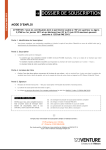

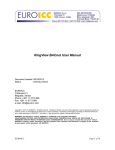

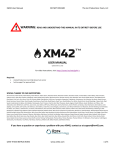
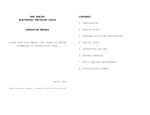
![HiSoft Devpac 3 (text version) [1992] [Manual: PDF]](http://vs1.manualzilla.com/store/data/005668901_1-67cf8256fc448cd2edf58a11a6ec729e-150x150.png)

